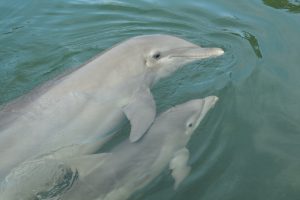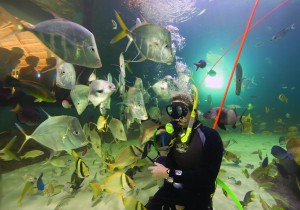In William Shakespeare’s “Romeo and Juliet,” Juliet made a passionate speech insisting that a rose by any other name would smell as sweet. In the Florida Keys’ Marathon, however, name-related discussions are likely to avoid roses and focus instead on how the Middle Keys islands got their offbeat monikers.

Marathon is widely renowned for its Turtle Hospital. Here, staffers Bette Zirkelbach and Richie Moretti, helped by volunteers, prepare to release Booga, a 125-pound loggerhead sea turtle, after treatment and rehabilitation at the hospital. (Photo by Bob Care, Florida Keys News Bureau)
Recognized as a prime Florida Keys boating and family destination, the Marathon and Middle Keys area is made up of a group of small islands whose names are as colorful as their vivid nightly sunsets. They include Boot, Knights, Hog, Vaca, Stirrup, Crawl and Little Crawl keys — plus Pigeon Key beneath the Old Seven Mile Bridge, East and West Sister’s Island, Deer, Fat Deer, Long Pine and Grassy keys.
Marathon itself earned its name from workers constructing the monumental Florida Keys Over-Sea Railroad from mainland Florida throughout the Keys in the early 1900s. Laboring night and day to meet the grueling construction schedule, workers reportedly complained, “This is getting to be a real marathon!”
Beneath the Old Seven Mile Bridge, the railroad’s centerpiece, lies the tiny island of Pigeon Key. Its name, appearing in an 1849 account, may have been inspired by the flocks of white-crowned pigeons that roosted there. Today Pigeon Key features a museum with artifacts from the Florida Keys railroad era, and offers opportunities to picnic and snorkel.
Stirrup Key, surprisingly, wasn’t named for the foot supports that are part of a cowboy’s saddle. According to documentation, in 1763 a Bahamian sea captain called Stirrup visited the Florida Keys — and left a lasting mark.
Crawl Key quite possibly got its name from the sea turtle pens or “kraals” found there. Another story says the island, called Kraal Key on at least one antique survey map, contained buried treasure.

Merina and Windley are two of the dolphins that have a nurturing home at Dolphin Research Center on Grassy Key.
The history of some Middle Keys place names is intriguingly vague.
Much of the city of Marathon lies on Key Vaca, whose name can be traced back to the 1670s and perhaps earlier. Experts are unsure whether it derived from “vacas,” the Spanish word for cattle, in recognition of cows that may have roamed the area; “Vaccas,” supposedly the surname of a friend of the land’s early Spanish owner; wandering manatees (also called sea cows) or even long-ago exploration chronicler Alavar Nunez Cabeza de Vaca.
As well as unusual place names, the Middle Keys area is home to some amazing environmental attractions.
Check out Marathon’s Turtle Hospital, widely known as the world’s first state-licensed veterinary hospital for sea turtles. Since 1986, hospital founder Richie Moretti and his dedicated team have been treating injured sea turtles and, whenever possible, returning them to their saltwater home.
If their conditions are too severe to allow release, they become permanent residents of the caring facility. Tours are offered daily so you can learn about the hospital and meet its “patients.”

Onlookers watch as submerged divers feed tropical reef fish in the 200,000-gallon aquarium tank at Florida Keys Aquarium Encounters. (Photo by Bob Care, Florida Keys News Bureau)
Also on Marathon is Florida Keys Aquarium Encounters, a unique spot where you can swim with and feed fish while learning about the region’s marine habitats.
Visitors can safely feed sharks and other predators through small holes in a thick acrylic barrier. Another highlight is interacting with debarbed spotted eagle and cownose stingrays. You can even experience a fascinating immersive coral reef encounter.
Or visit Grassy Key’s Dolphin Research Center, founded in 1984 as a not-for-profit marine mammal research and education facility. DRC is home to a family of Atlantic bottlenose dolphins and California sea lions — some born there, and some that came from other facilities or were rescued but couldn’t be released into the wild.
The center and its staff promote peaceful coexistence, cooperation and communication between marine mammals, humans and the environment. Visitors can enjoy daily narrated dolphin and sea lion behavior sessions and educational presentations, plus interactive programs including Researcher Experience and Ultimate Trainer for the Day.
Want to find out more about the Middle Keys and their fascinating environmental attractions? Then make travel plans today … and discover a group of islands whose appeal is as unforgettable as their names.

